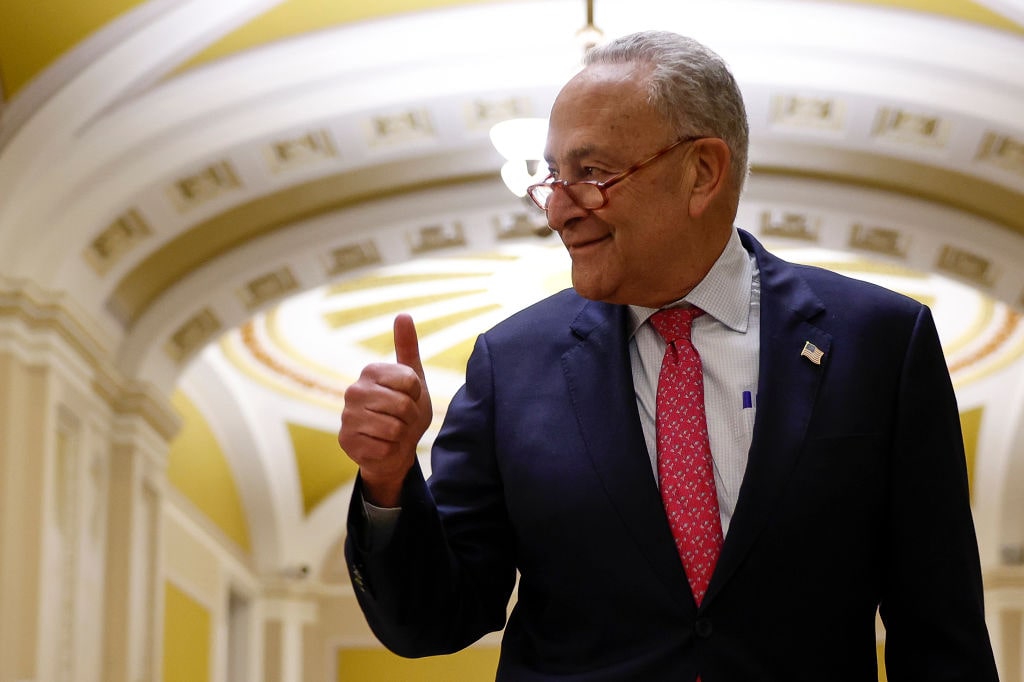For the next 19 months, the curtains will be closed for the debt ceiling political theater season. The federal government will add about $4 trillion to the national debt heading into 2025. Then the drama will unfold again, and either President Joe Biden or the Republican nominee will be forced to grapple with another edition of the debt limit fight. But the more things change, the more they stay the same. This was true on June 1, 2023, and it will still be the case on Jan. 1, 2025.
Senate Passes Debt Ceiling Bill
The late June 1 session started just after 7:30 p.m. and lasted several hours as lawmakers sifted through nearly a dozen amendments to the Fiscal Responsibility Act. Senate Majority Leader Chuck Schumer (D-NY) warned his colleagues not to engage in the amendment process because the leadership wanted to keep the Biden-McCarthy package intact. Around 11 p.m., the senators held the vote to give the thumbs up or thumbs down to the deal. Ultimately, the bill passed 63 to 36, with a mix of Republicans and Democrats on both sides of the vote.
In a post-vote news conference, Schumer gave himself, the president, and his party a round of applause, telling reporters following the bill’s passage that the Democrats “saved the country from the scourge of default.”
“Default was the giant sword hanging over America’s head. But because of the good work of President Biden, as well as Democrats in the House and Democrats in the Senate, we are not defaulting,” he said. “So, tonight’s outcome is very welcome news for our economy and for American families.”
 President Joe Biden issued a statement after the Senate vote, thanking Schumer and Minority Leader Mitch McConnell (R-KY) “for quickly passing the bill.” He added: “No one gets everything they want in a negotiation, but make no mistake: this bipartisan agreement is a big win for our economy and the American people.” Biden plans to sign the legislation as soon as possible and intends to address the public directly on June 2.
President Joe Biden issued a statement after the Senate vote, thanking Schumer and Minority Leader Mitch McConnell (R-KY) “for quickly passing the bill.” He added: “No one gets everything they want in a negotiation, but make no mistake: this bipartisan agreement is a big win for our economy and the American people.” Biden plans to sign the legislation as soon as possible and intends to address the public directly on June 2.
Is it time to close the book on the debt ceiling? Not quite.
Backroom Deals Begin
In a Capitol Hill scrum on June 1, Sen. Mike Lee (R-UT) told reporters that when officials look back at this agreement a year or two from now, it will be proven that it “will not have saved anything, not a dime” and “probably would have cost us more.” The latest announcement could prove him to be correct.
McConnell and Schumer issued a rare joint statement, noting that the upper chamber would try to pass 12 annual spending bills this year to prevent the across-the-board spending cuts outlined in the Fiscal Responsibility Act. According to Schumer, GOP senators had pressed him about doing something like this as they were not pleased with what House Republicans agreed to with the administration.
“The caps may be too low. We felt that the caps are too low on non-defense discretionary,” Schumer explained to reporters. “So, McConnell and I put out a joint statement in that we would look at finding ways to fund things that were really needed, through emergency and other ways. But also through the regular appropriations process, which was always going to go forward.”
As the bill is written, federal agencies could face a 1% across-the-board reduction if Congress fails to approve funding bills by Jan. 1.

(Photo by Anna Moneymaker/Getty Images)
One of the culprits behind this request might have been Sen. Lindsey Graham (R-SC), who complained on the Senate floor that the bill decreases defense spending. The fiscal year 2024 defense budget is $886 billion, a 3% year-over-year increase. In the fiscal year 2025, defense spending would be capped at $895 billion, a 1% jump from the previous year. “If this budget is the end of the discussion and we don’t fix it, your sons and daughters are going to have more war, not less,” he said.
What’s Next?
By the time the 2024 presidential election is over, Uncle Sam will have added about $4 trillion to the current $31.4 trillion national debt. Fiscal Responsibility Act proponents purport this is the first step to restoring fiscal sanity in Washington. But the reality is that the bill enables the insanity because any cuts or rescissions were drops in the bucket compared to long-term challenges. The spending caps outlined are estimated to result in about $1.5 trillion in spending cuts over the next ten years. By comparison, the US government will spend $80 trillion in this same span. Of course, this assumes that the leadership keeps the package intact and refrains from cutting corners and using loopholes to erase these cuts. In the end, it is as clear as the gel in Gov. Gavin Newsom’s (D-CA) hair that House Speaker Kevin McCarthy (R-CA) got played.
All opinions expressed are those of the author and do not necessarily represent those of Liberty Nation.
Do you have an opinion about this article? We’d love to hear it! If you send your comments to [email protected], we might even publish your edited remarks in our new feature, LN Readers Speak Out. Remember to include the title of the article along with your name, city, and state.
Please respect our republishing guidelines. Republication permission does not equal site endorsement. Click here

